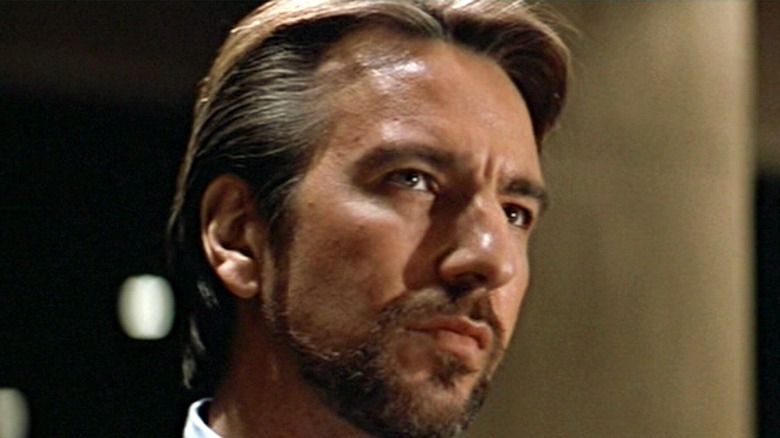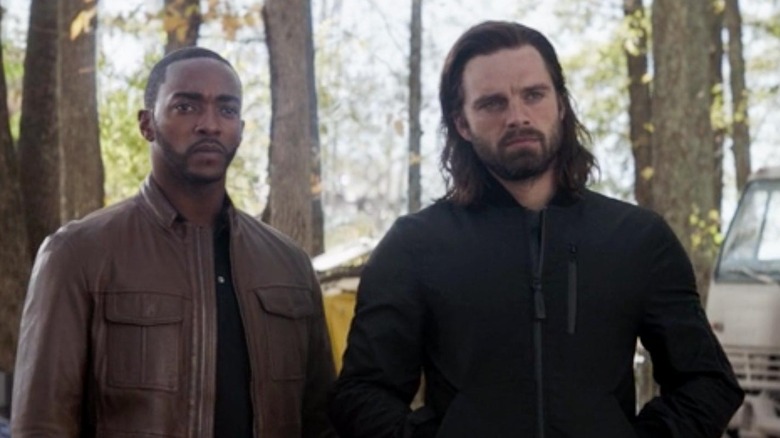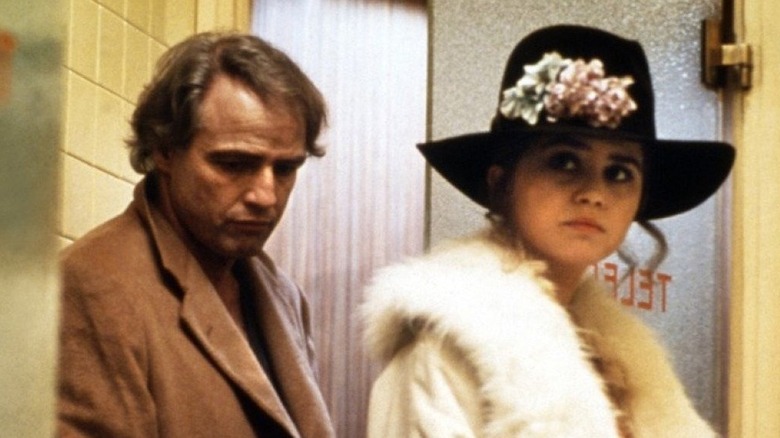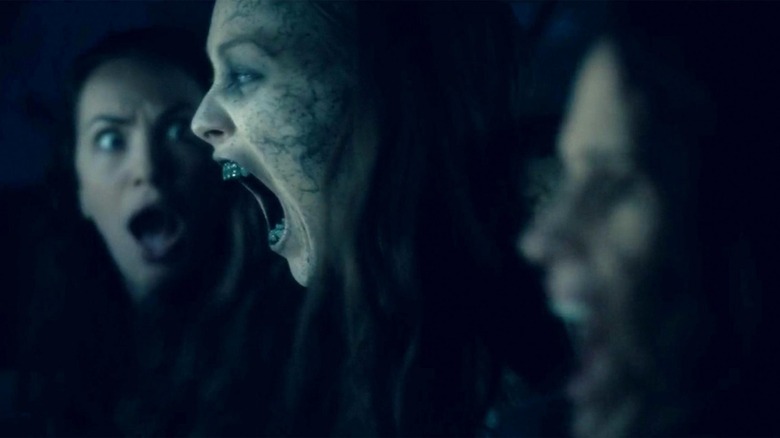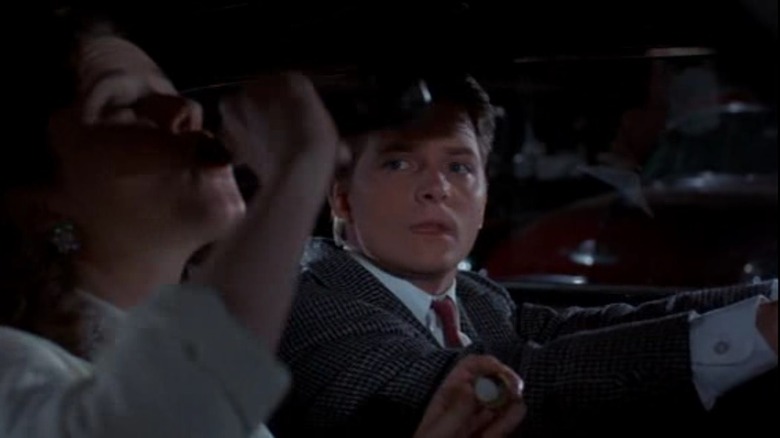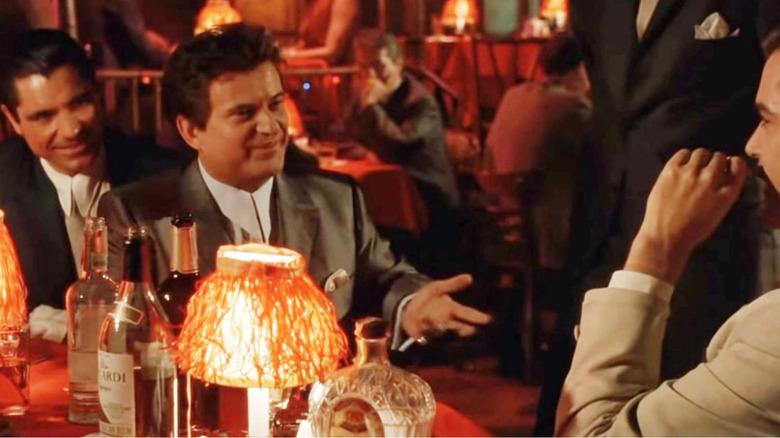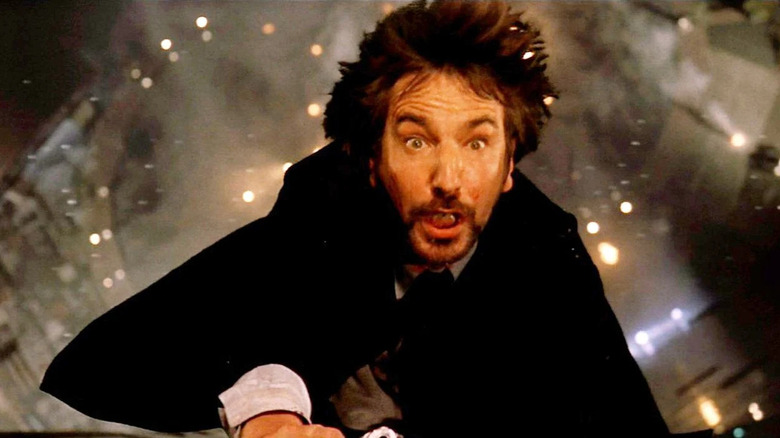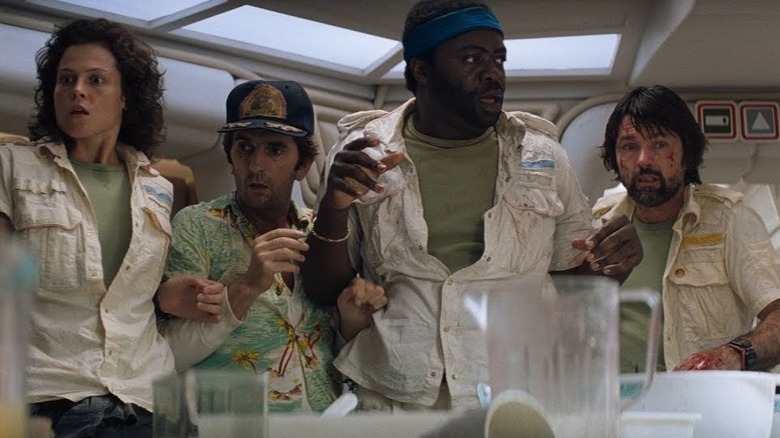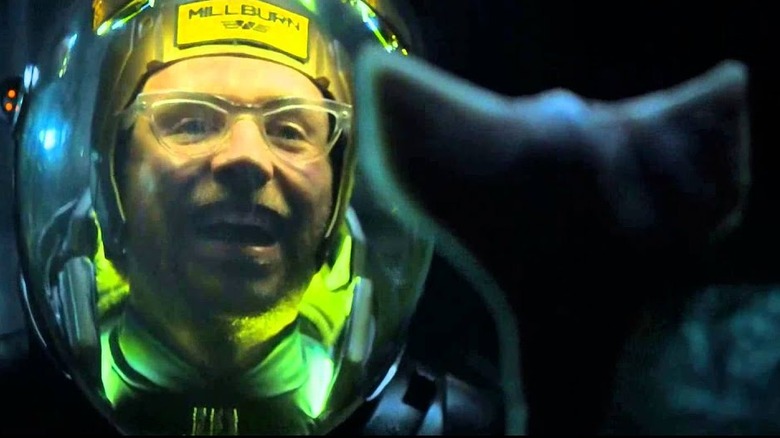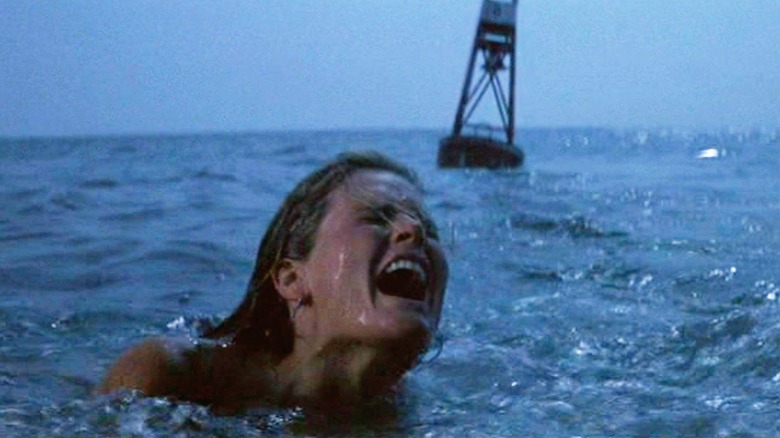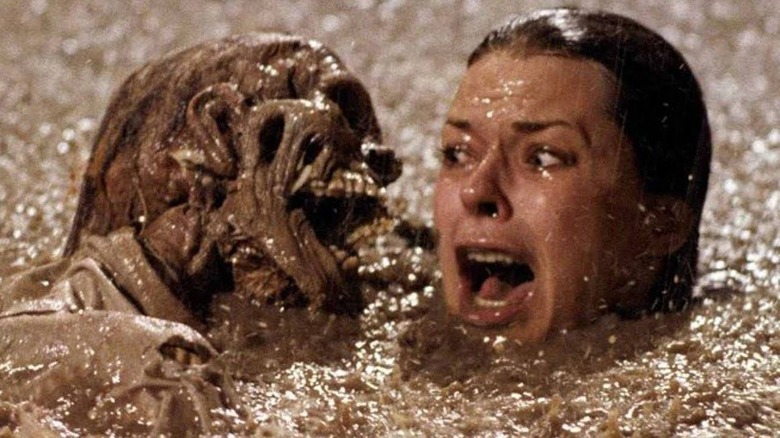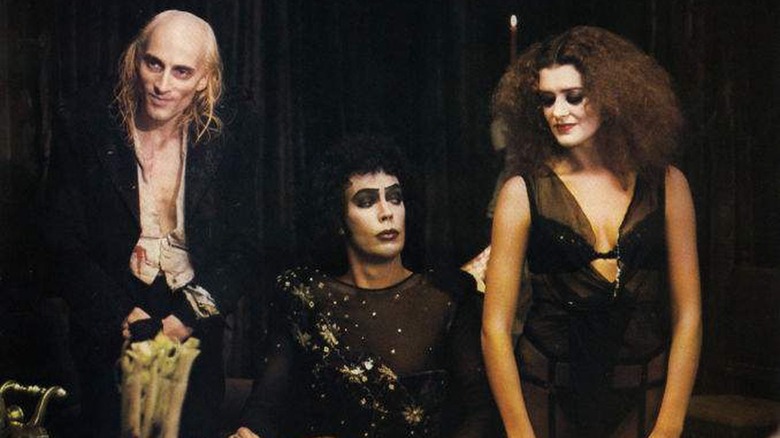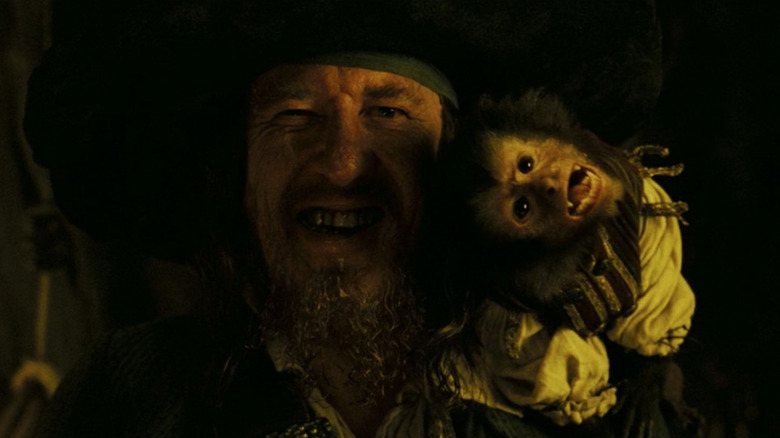Why These Actors Were Told Lies While Filming Scenes
Despite acting being pretty much the full job title of an actor, directors can't always bring themselves to trust their cast to portray emotions convincingly enough for their liking. In these situations, certain directors (mainly Ridley Scott) resort to setting up a scene in such a way that their actors don't fully know what's going to happen. In other words, they lie to them.
That's not the only reason directors lie to their cast. Sometimes, as in the case of one very popular superhero franchise, the studio has learned from experience that actors tend to struggle to keep spoiler-heavy secrets to themselves. (Speaking of spoilers, expect to have elements of every movie mentioned in this piece ruined. Just being honest).
In most cases, the lies are pretty benign. Once the actors' heart rates have slowed back to normal, and they've stopped screaming, there's no lasting damage — and audiences have the treat of seeing genuine shock and surprise. But in at least one incident, one of the actors involved suffered very real mental anguish as a result of her director and lead actor's decision to lie to her.
Here's a closer look at why these actors were lied to for a scene, from the hushed-up return of a favorite character to a jump scare so real it even frightened the man who planned it.
The cast of Endgame thought this funeral scene was a wedding
Given all the times Tom Holland and Mark Ruffalo have let an MCU spoiler slip, you can't blame the bosses at Marvel for trying to keep their actors in the dark when it came to the plot of "Avengers: Endgame."
The Russo brothers went so far as to write alternate endings and fake scenes. They also gave most of the actors scripts containing only their own scenes (some of which presumably weren't real.) For at least one real scene that involved most of the cast, they resorted to lying to the actors about what they were filming, as the rest of the world learned from Sebastian Stan on "The Tonight Show."
Stan, aka Bucky Barnes, explained to Jimmy Fallon that he only found out what he was shooting when he arrived on set every day. (So if Barnes looks confused, that's why.) At one point, he and everyone else was told that the reason they were wearing formalwear for a scene was for a wedding. "Two people weren't there, so I guessed that was the bride and the groom," he said.
Although Barnes doesn't specify, it's implied that the scene was actually Tony Stark's (Robert Downey Jr.) funeral. The other missing Avenger was presumably the recently deceased Natasha Romanoff (Scarlett Johansson).
Stan wasn't even supposed to admit that. After letting the wedding detail slip, he backtracked. "But that's what it was, it was a wedding," he added, too late.
Bernardo Bertolucci and Marlon Brando lied to Maria Schneider about this Last Tango in Paris scene
Warning: This slide discusses sexual assault.
Directed by Bernardo Bertolucci, 1972's "Last Tango in Paris" starred Marlon Brando as Paul, an aging American who engages in an anonymous sexual relationship with a younger French woman, Jeanne, played by Maria Schneider. Paul becomes increasingly controlling and eventually rapes Jeanne, using butter as a lubricant.
Bertolucci later claimed that the rape scene was always in the script, minus the butter detail. He admitted that he and Brando sprang that on the actress at the last second because he wanted to capture her real response. "I didn't tell her what was going on, because I wanted her reaction as a girl, not as an actress. I wanted her to react humiliated," he said. It worked: "Even though what Marlon was doing wasn't real, I was crying real tears," Schneider later told the Daily Mail.
She also said, "That scene wasn't in the original script." It's unclear whether she meant the rape scene or the use of the butter. Either way, the shoot, the scandal over the scene, and its impact on her career deeply affected Schneider, who says that she experienced a breakdown as a result. According to Schneider, Brando never apologized: His attitude, she said, was, "It's just a movie."
If you or anyone you know has been a victim of sexual assault, help is available. Visit the Rape, Abuse & Incest National Network website or contact RAINN's National Helpline at 1-800-656-HOPE (4673).
This Haunting of Hill House jump scare was terrifying for the actors, too
Netflix's adaptation of Shirley Jackson's novel "The Haunting of Hill House" was so well-received by horror-hungry audiences that it was renewed as an anthology series a few months after its release. One of the most memorable moments was a shock not only to viewers, but also to the actors.
Sisters Lulu (Elizabeth Reaser) and Theo (Kate Siegel) are driving back to their terrifying childhood home, Hill House, to save their brother Luke (Oliver Jackson-Cohen) from becoming its next victim.
The women are arguing because Lulu believes Theo is having an affair with her husband. Suddenly, the ghost of their dead sister Nell (Victoria Pedretti) bursts through the gap between their seats, screeching like a banshee. As you can imagine, the sisters, to use a technical term, completely freak out. Lulu pulls off the road and Theo jumps out and runs.
Reaser and Siegel knew that the scream was coming, but series creator and director Mike Flanagan told Pedretti to interrupt them 30 seconds earlier than they were expecting, so they would be genuinely scared. If it's any consolation to the two actresses, he admitted, "It also scared the s*** out of all of us at the monitor."
The crew pulled a prank on Michael J. Fox while shooting this Back to the Future scene
In "Back to the Future," accidental time-traveler Marty McFly (Michael J. Fox) discovers that his forms of teenage rebellion — cutting class, reckless skateboarding, sneaking off to the lake with his girlfriend — have nothing on what his mom (Lea Thompson) was up to at his age. She smokes, she "parks" with boys (as the '50s parlance phrased it), and she steals alcohol from her mom to sneak before prom.
Thanks to a tangle of time-jumping plot lines, in one memorable scene, Marty has to very reluctantly hit on the teenage version of his own mother. (Don't overthink it.) Given this scenario, you can't blame him for accepting a sip from that bottle.
In the final version of the scene, Marty gets through a few gulps before spitting it out in shock at the sight of his mom smoking. Fox got a different kind of surprise while shooting one take. The crew decided to play a joke on him, replacing the nonalcoholic contents with real hooch. Fox dutifully took a swig — and suddenly realized what he was drinking. The crew started laughing in the background, and Fox joined in. Not all lies deliver an exceptional scene, just fun bloopers.
Joe Pesci scared the cast of Goodfellas for real
Joe Pesci is famous for playing characters with a dangerous streak, and for bringing that manic intensity to set. Exhibit A: Macaulay Culkin's right index finger, which Pesci bit hard enough to leave a scar when he and the nine-year-old were filming "Home Alone."
Pesci honed that unpredictability in his "Goodfellas" character Tommy DeVito. And just like DeVito's Mafia conspirators, his castmates couldn't always tell which side of Pesci they were dealing with. Director Martin Scorsese leaned into this trait for one of the movie's many famous scenes. He also leaned into Pesci's real-life interactions with the mob.
Ray Liotta, who played DeVito's fellow Mob member Henry Hill, has said that Pesci was on the receiving end of a similar exchange when he told a gangster he was waiting on at a restaurant that he was funny. Scorsese loved the story and had it written into the script. This time, Pesci was the unamused, volatile gangster, opposite Liotta's naive rookie.
But Scorsese didn't tell the other cast members what was going to happen. So when Pesci asked Liotta, "Funny how?" the shift you see in the group was their genuine response. Scorsese deliberately shot from a medium range — with no close-ups — so audiences could see the dread on everyone's faces. It demonstrated the threat of violence always simmering beneath even the most casual conversations between Mafia members.
Alan Rickman was not expecting this dramatic Die Hard moment
Actors like to brag about doing their own stunts, but in many cases, they quickly find out why it's best to leave them to a professional. The late, great Alan Rickman took the plunge for the climactic scene of "Die Hard," in which his character, Hans Gruber, falls off the top of the Nakatomi Plaza skyscraper. And it didn't go completely smoothly.
Right up to the seconds before his death, when he's dangling out of the window 35 stories up, Gruber has been the unflappable bad guy. His sneering veneer turns to terror as his nemesis John McClane (Bruce Willis) removes the wristwatch that has been preventing Gruber from falling. That expression reportedly wasn't just down to Rickman's much-praised acting talents. Stunt coordinator Charlie Picerni revealed to a Netflix documentary that he told Rickman he would drop 40 feet on the count of three — and told the stunt crew to drop him on one. Hence the look of surprise.
Rickman said that he doesn't remember the counting. He mostly recalls that the producers were horrified when he eagerly signed up to do the stunt himself. "They were very careful to make it my very last shot of the film," he said.
The Alien cast didn't know what was coming
Stanley Kubrick couldn't figure out how Ridley Scott made the chest-bursting scene in "Alien" look so realistic, and neither could the people who watched it happen in real-time — because they weren't told what they were in for.
In an oral history in 2009, the cast recalled that the script for that scene was deliberately vague, and they were kept off the set until the last minute. Only John Hurt, owner of the chest that the Xenomorph burst out of, was prepped in advance. He was set up with the fake chest filled with raw meat. (It smelled exactly as good as you'd think, according to Veronica Cartwright). Realizing that the crew and the entire room were covered with raingear only worsened the cast's sense of trepidation as they walked onto set.
Genuinely perplexed and nervous, as the cameras rolled, the actors crowded around to see what was happening in Hurt's (fake) chest. When the alien burst through, a spurt of fake blood hit Cartwright in the mouth, and she passed out. Yaphet Kotto confirmed, "We didn't see that coming. We were freaked. The actors were all frightened." As scary as it was, Sigourney Weaver understood Scott's reasoning. "You can act, sure, but when you're surprised, that's gold," she said.
Ridley Scott used shock tactics to get a reaction on the set of Prometheus
Ridley Scott is never one to pass up a faked reaction when a real one is just a lie-by-omission away. He applied this theory of direction to the set of "Prometheus" as well as to "Alien." One scene in particular generated a very real response from the actor involved.
The first member of the Prometheus crew to meet a gruesome end is biologist Millburn (Rafe Spall). Apparently, despite being a prominent student of new lifeforms, he doesn't have the sense not to touch a previously undocumented alien species. The so-called Hammerpede, a snake-like creature, makes its way into Millburn's spacesuit and down his throat, which proves fatal.
The rest of the crew learns about Millburn's grim death the hard way: by finding his corpse. It was especially hard on actress Kate Dickie, whose character, Ford, was the one who discovered their former crewmate. Creature and special makeup effects supervisor Neal Scanlon recalled that Scott deliberately didn't tell Dickie that the Hammerpede that killed Millburn was still in his suit and was going to jump out at her; she just thought she would stumble on the body.
The special effects crew put the Hammerpede into the spacesuited dummy. When Dickie rolled the dummy over, they yanked it out. As Neal recalls, "it was clearly an enormous shock to her. The screams are real."
Jaws' first victim didn't see the shark coming
The opening scene of "Jaws" let viewers know exactly what to expect from the rest of the movie, namely creepy music and a violent, invisible killer. But the person at the center of the moonlit scene was left in the dark about the specifics.
Susan Backlinie played Chrissie, the shark's first onscreen victim. Backlinie got the part because she was a stuntwoman. As she had pointed out to director Steven Spielberg, she knew how to sell the shot.
However, the scene was more grueling than she might have pictured it from the safety of dry land. Backlinie was topless from the waist up, and from the waist down she wore jeans under a harness connected to cables. To make it look like the unseen shark was dragging and shaking her, groups of men pulled on the cables, which were attached at her hips and front, yanking her back and forth.
Spielberg — who stayed in the cold water with her the whole time — instructed them not to tell Backlinie when they were going to pull. Backlinie noted that given how much she was screaming, no one would ever have known if she was in real danger. For Chrissie's final moment, when she's dragged underwater, Spielberg took the ropes himself and pulled Backlinie under without warning. He later described the scene as "one of the most dangerous things that happened."
JoBeth Williams was horrified when she learned the truth about this Poltergeist scene
There are occasions when it might be better not to know certain details about a scene until it's already been shot. Just ask JoBeth Williams.
So many bizarre things happened on the set of "Poltergeist" that the movie was rumored to be haunted or cursed. In a Reddit AMA, Williams noted that, sadly, several of the cast and crew died after shooting the movie, including actresses Heather O'Rourke (due to a congenital condition) and Dominique Dunne, who was killed by her ex-boyfriend months after "Poltergeist" was released. Williams added that she didn't think it was an unusually high number.
However, one thing Williams did find creepy was the use of real skeletons in the mud pool scene — something she didn't learn about until sometime later, along with, she said, the rest of the crew.
When "Poltergeist" was shot, plastic skeleton replicas were very expensive to make. In a deposition for an unrelated lawsuit, the movie's special effects makeup artist, Craig Reardon, testified that he had acquired real human skeletons for the movie. He explained that they are intended to be used in classrooms, and that he and his team modified them to be less doctor's office and more haunted house.
Williams was the one who unknowingly spent five days shooting in a giant muddy pool with the bones of real people. "I think everybody got real creeped out by the idea of that," she said later.
The cast of the Rocky Horror Picture Show didn't see this twist coming
"The Rocky Horror Picture Show" is not one for people who don't enjoy surprises. But even the cast wasn't in on one particularly morbid twist. (Fair warning: Skip this one if you're eating, especially if you don't eat meat. Or if you love meat and would like to continue to eat it.)
Richard O'Brien and Patricia Quinn — who played siblings Riff Raff and Magenta, the world's most deranged servants, respectively — have both said that director Jim Sharman kept a major secret about the dinner party scene between himself and Tim Curry.
After everyone has tucked into slices of unnamed meat, while pondering the mysterious disappearance of Eddie (Meat Loaf) in a song, Frank-N-Furter (Curry) whips off the tablecloth, revealing Eddie's mutilated corpse under the table. Now the meat has a name!
Only Curry and Sharman knew this was going to happen, and the rest of the cast's reactions are real. You can see Peter Hinwood, who played Rocky, laughing before he has to pretend to comfort Susan Sarandon's Janet. O'Brien said that Sharman "wanted a natural reaction," and that "it came as a real shock." Quinn started laughing hysterically until O'Brien eventually told her to shut up — a moment that made it on screen. Well, Meat Loaf isn't to everyone's taste.
This Pirates of the Caribbean character made a surprise return
Whereas real 18th-century pirates were probably fairly unpleasant to encounter, the fictional ones in the "Pirates of the Caribbean" franchise are roguishly lovable, even the villains. So when a character we previously thought perished in the first movie showed up right at the end of the second, fans were pleasantly surprised — and so was the cast.
As the second "Pirates" movie, "Dead Man's Chest," draws to a close, all seems lost. Jack Sparrow (Johnny Depp) has been captured by the ruthless Davy Jones (Bill Nighy), who has badly damaged the Black Pearl and killed most of its crew. The survivors gather with obeah priestess Tia Dalma (Naomie Harris), who delivers the savior they didn't know they needed: Captain Barbossa (Geoffrey Rush), who was last seen dead from Sparrow's final bullet at the end of the first movie, "Curse of the Black Pearl."
According to the DVD commentary, Rush's return was also a surprise to the cast, who had been told to expect Anamaria, a pirate played by Zoe Saldana in "Pearl." Rush, for one, was delighted to reprise his role. He said that when director Gore Verbinski told him about the twist, "My mind was boggling with the potential of that, the story lines that could come out of that." He's not wrong — but can anyone explain what actually happened in the third movie?
